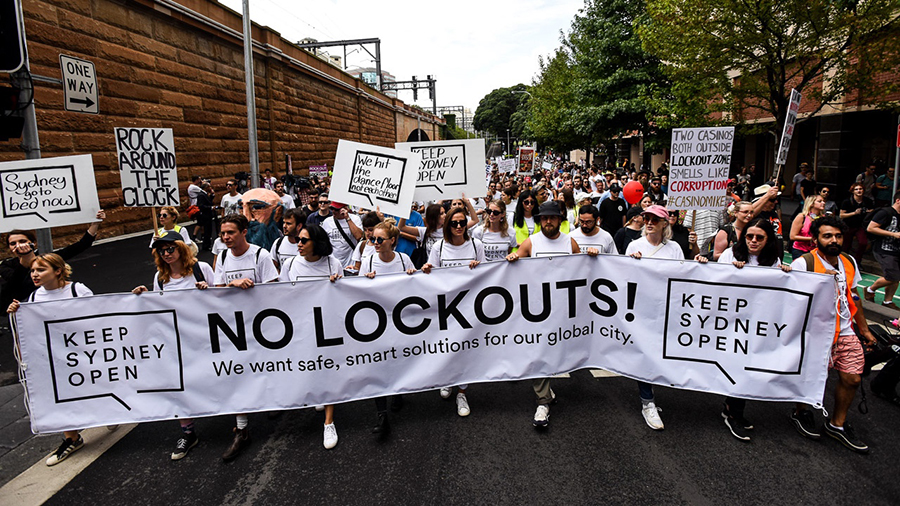Just over a week ago, for the second time in the year, thousands flocked to the Sydney CBD to show their support for Sydney nightlife. Since the introduction of lockout laws in 2014, a diligent cohort of activists have been protesting against the death of our dear city’s vibrancy.
Keep Sydney Open has been a veritable leader of this movement, and the main organiser of every large scale battle cry since February 2014.

As the debate surrounding NSW’s government-enforced predicament rages on, we take a look at some hard numbers behind the movement to Keep Sydney Open.
It’s hard to believe it’s been two and a half years since the introduction of lockout laws following public incidences of violence in Sydney’s entertainment district. These days, the imposition of curfews onto the lives of adults has become the norm.
While some may be content to take a back seat when it comes to questioning the powers that be, there will always be a special few who fight in the face of authoritarianism. Sincere, well founded rebellion is inspirational, so it’s no wonder the Keep Sydney Open movement has gained so much traction by this point.
But is KSO’s blinding three year gallop finally slowing to a canter?

While thousands of people attended the rally earlier this month, the crowd wasn’t even a third the size of the first rally. What happened between February and October?
Did the masses become disenfranchised enough to believe there really was nothing we could do in this fight? Where did the inspiration go? The rally, while once again an enormous feat of the KSO organisers and a privilege to be a part of, was simply the cry of a vocal minority. A shrinking vocal minority.
Yes, it’s been two and a half years, but did you forget the facts?
In April, the Australian Performing Rights Association (APRA) submitted a review of the changes to liquor laws. Using their access to data like ticket sales, venues’ expenditure on artists and licensing statistics, they uncovered some gut-wrenching numbers.
Since Febuary 2014 within lockout areas, there had been a 15% reduction in performer pay, a 19% reduction in attendance figures and a 40% decrease in ticket sales. This is in addition to over 30 venues that have been forced to close in the same time period, according to the divisive Callinan report.
It hurts, and the city is bleeding money from these deficits. However, as we’re told, the streets are safe now.
According to the latest report on alcohol related violence in Sydney from the Bureau of Crime Statistics and Research (BOSCAR), there has been a drop in the number of non-domestic assaults in the lockout zones since 2014.

We checked the statistics presented in that report against the nifty BOSCAR Crime Trends tool (don’t click that if you have something you need to do – it’s a hell of a time sink), and they held up. In the Sydney local government area, which includes Kings Cross, Oxford Street, Sydney CBD and all the largest pubs in Newtown, there has been a marked reduction in violence.
The BOSCAR report cites a 45% reduction in total non-domestic assaults in Kings Cross since lockouts, and a 20% drop in the Sydney CBD.
As the NSW government keeps telling us, you can’t argue against this. If people are getting hurt… someone needs to step in.
The thing is, at face value these statistics stand strong. But when comparing the time-specific stats from the BOSCAR report with City of Sydney’s 2015 Late Night Management Areas report, a new light shines brightly.

Yes, there has been a reduction in the total number of non-domestic assaults in lockout areas, but they stand against huge discrepencies in pedestrian traffic pre and post lockouts.
Kings Cross has seen a huge drop in assaults simply because the once iconic suburbs has seen a huge drop in people.
Sydney CBD, which was described as having a ‘stable’ number of assaults compared to pre-2014, has seen a massive increase in foot traffic, presumably a direct correlation to the reduction of punters visiting the Cross on weekends. This is actually the one positive to be gleaned from the BOSCAR report – somehow the CBD has seen significantly less assaults per person lately… but that begs another question.
Our earlier stats from the top-notch Crime Trends tool shows the total number of assaults in Sydney city dropped from 3,500 in the year before lockouts to 3,157 in the year after. That’s not 45%, or even 20%, which is what BOSCAR cited as the incident reduction in the Cross and the CBD respectively.
Where did all those slippery incidents run off to, BOSCAR?
Ultimo, Chippendale, Haymarket, Surry Hills, Darlinghurst and Newtown all sit within the zone Crime Trends identifies. Oh, and I almost forgot, there’s also Pyrmont and Darling Harbour, homes to a large casino and even larger development zone, both of which are exempt from lockouts.
Huh.

Anyway, these are things you likely already knew, or at least had pushed to the back of your mind. If you’ve lived in Sydney for long enough, these changes have been in plain sight.
If that overwhelming feeling of unfairness is back, that’s good. It’s real.
Plus, it can never hurt to inspire just a tiny bit of rebellious spirit now, can it?
Make sure you follow Keep Sydney Open for the latest updates, and sign their growing petition to remove the lockout laws here.
While you’re here, have your mind blown by these song facts about classic tracks.



